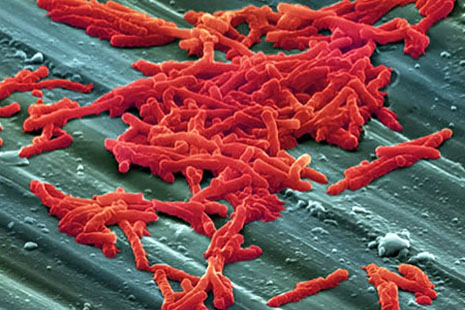First published in March 2013
AS RESEARCH projects go, it probably didn’t sound too earth-shattering for the volunteers who offered to help. Apart from demonstrating their good health, they simply had to give blood, stool and saliva samples, as well as have swabs taken from various locations on their bodies.
We will probably never know their names but the contribution of those 242 American men and women, who were willing to share the intimate details of their microbial profile with the world, is having a profound impact on our understanding of health and illness, and is even raising questions about what it means to be human. This research into the microbiome – the viruses, bacteria and other microbes living with us – also puts a whole new slant on some longstanding public health problems, like the overuse of antibiotics – but more on that later.
In June last year, after five years of work by around 200 scientists from eighty universities, the US-based Human Microbiome Project released the initial analyses of those volunteers’ donations. The results paint an extraordinary, though preliminary, portrait of the richness of our microbial life. The researchers found over 10,000 species of microbes living in and on their subjects, with each person carrying about eight million different bacterial genes (compared with 22,000 or so human genes). They described their findings as “the largest and most comprehensive reference set of human microbiome data associated with healthy adult individuals.”
“The more closely we look, the more bacterial diversity we find,” said one of the scientists, Susan Huse, from the Marine Biological Laboratory, when the microbiome “map” was released. “We can’t even name all these kinds of bacteria we are discovering in human and environmental habitats. It’s like trying to name all the stars.”
The research, published in a series of articles in Nature and Public Library of Science journals, found that the composition of our microbial load varies enormously, both between individuals and between sites within the same person. It also found that their functions are surprisingly similar – that many different types of microbial communities can do similar work. Or as one scientist put it, “apparently, there are many different ways to be healthy when it comes to our microbes.”
Just as we unconsciously help the microbes in their quest for survival, so do many of them return the favour, whether by producing beneficial compounds, helping us to digest our foods, or boosting our immune system. By colonising our skin, gut and other surfaces, they help reduce the opportunities for more dangerous bugs to take hold. The research found that most healthy people carry pathogens, or microbes capable of causing disease, prompting some speculation that there may be hitherto unrecognised benefits from such relationships.
At a National Institutes of Health briefing accompanying the release of the findings, Phillip Tarr, director of paediatric gastroenterology and nutrition at Washington University School of Medicine in St Louis, said that research into the human microbiome offers “a whole new way of looking at human biology and human disease.” According to Tarr, “We’ve now been introduced to this biomass in each and every one of us. These organisms, these bacteria are not passengers. They’re metabolically active. As a community, we have to reckon with them much like we have to reckon with the ecosystem in a forest or a body of water.”
With most of us carrying ten times more microbial than human cells (although they make up only a small proportion of our body mass), some researchers now talk of us as “human ecosystems” or “super organisms.” As Amy McGuire, an associate professor of medicine and medical ethics at Baylor College of Medicine in Houston, told the briefing, the ethical, legal and social implications of the emerging field of microbiome science are profound. “There are also very interesting questions about whether the fact that we have more microbial DNA in and on our bodies than human DNA changes how we think about what it means to be human,” she said.
The upsurge of scientific interest in the human microbiome came when scientists working on the Human Genome Project realised that so much of the genetic material they were discovering wasn’t of human origin. They investigated further, helped by technological advances that enabled DNA sequencing at a fraction of the previous cost.
Another lesson from the genome project was the wisdom of establishing a reference database of a “normal” human microbiome. Hence the release of the volunteers’ data last year, with the goal of enabling further investigations. As one of the Nature papers says, “Collectively the data represent a treasure trove that can be mined to identify new organisms, gene functions, and metabolic and regulatory networks, as well as correlations between microbial community structure and health and disease.”
While these are early days in this burgeoning field of research, it seems to signal a profound shift in our relationship with the microbial world. “This is only the beginning,” writes Joy Yang, a researcher at the National Human Genome Research Institute. “We have learned that the bacteria living in and on us are not invaders but are beneficial colonisers. The hope is that, as research progresses, we will learn how to care for our microscopic colonisers so that they, in turn, can care for our health.”
YET we’ve been doing the opposite for many years by waging a long-running war with our microbiome. This has often been unintentional, through shifts in our food supply and way of life, or even in the way we give birth. (It’s been suggested, for example, that the global growth in caesarean deliveries may have reduced the transmission of health-giving microbes from mother to baby.) But much of the warfare has been deliberate, conducted via an arsenal of antibiotics, antibacterial wipes and other efforts to avoid germs. If ever there has been a campaign to demonstrate the wisdom of the statement that “you can no more win a war than you can win an earthquake” (credited to Jeannette Rankin, a pacifist and the first woman elected to the US Congress), then this is it.
From the earliest days of antibiotics, the bugs fought back. In a 1945 interview with the New York Times, the scientist who first observed the antibacterial properties of mould, Alexander Fleming, sounded an alarm about overuse of penicillin and the development of resistance. According to Lyn Gilbert, an infectious diseases physician and clinical microbiologist at Westmead Hospital in Sydney, it was only a short time after penicillin became available for treatment of civilians in Sydney in 1946 that a resistant strain of Staphylococcus aureus was found in about half of the surgical wound infections at the Royal Prince Alfred Hospital.
While much concern about antibiotics overuse has focused on how it promotes the emergence of treatment-resistant organisms, perhaps the collateral damage has been much more profound. “The Menace of Antibiotics” was the title of a plenary presentation at a major infectious diseases conference in San Francisco last October by Martin Blaser, a physician, epidemiologist, and professor of microbiology at NYU School of Medicine.
A former president of the Infectious Diseases Society of America, Blaser holds senior advisory positions with the National Cancer Institute and the National Institutes of Health. His talk covered many of the concerns he has raised in journal articles in recent years, suggesting that antibiotics have affected the microbiome in ways that have had adverse long-term health consequences.
Blaser suggests, for example, that the widespread eradication of Helicobacter pylori (a bacterium associated with stomach inflammation and duodenal ulcers) may be implicated in the rise of conditions such as obesity, type 2 diabetes and asthma. He also argues that the eradication of relatively benign bacteria leaves us exposed to the risk of being colonised by more harmful bugs.
Blaser’s concerns are based largely on experimental and epidemiological evidence and are not proven, but he is sufficiently alarmed to have gone on the record calling for caution in the use of antibiotics during pregnancy and childhood, noting that the average child in developed countries has received between ten and twenty courses of antibiotics by the age of eighteen.
At the Institute for Molecular Bioscience at the University of Queensland, Matthew Cooper also advocates a more judicious use of antibiotics, particularly the broad-spectrum types, and thinks it is sensible to avoid using antibiotics in children unless absolutely necessary. He agrees that the drugs may affect our microbial colonisers in ways we don’t yet understand, but stresses that the implications of the microbiome for health are complex and will not quickly or easily be understood.
Much of the research to date, Cooper points out, is showing associations between characteristics of the microbiome and disease, rather than cause and effect. One exception is a small European clinical trial that recently generated international headlines after finding that faecal transplants were more effective than conventional antibiotics in treating recurrent Clostridium difficile infection (a potentially serious form of antibiotic-associated diarrhoea). An accompanying editorial in the New England Journal of Medicine predicted that the findings would encourage wider trials of “intestinal microbiota therapy” for inflammatory bowel disease, irritable bowel syndrome, bowel cancer prevention and metabolic disorders. Other scientists are now looking at ways to transfer the “good” bacteria in the form of pills.
Cooper has been sufficiently impressed by the emerging evidence in another area to turn himself into a guinea pig. After reading studies suggesting that a high-fibre diet produces a type of bacteria in the gut that is associated with reversal of lung disease in mice, he put himself on a high-fibre supplement for two years to see if it would help his asthma. “I thought, what the hell, have a go,” he says. “I was taking a steroid every day for asthma for twenty years.” Now, he adds, “I am no longer taking asthma medication.”
Cooper stresses that a study like this, with only one subject and no controls or placebos, is meaningless. But his research group is now studying the role of by-products of good bacteria, molecules termed short-chain fatty acids, and how they interact with key receptors in the human gut. These receptors bind to the fatty acids produced by good bacteria in response to a high-fibre diet, and then modulate inflammation in the body – one of the causes of diseases such as asthma.
While any wider significance to Cooper’s self-experiment is not yet clear, he does hold to the adage that “you are what you eat.”
IN HIS small office on the sprawling campus of the John Hunter Hospital in Newcastle, John Ferguson is bolting down a sandwich while giving an overview of recent developments in antibiotic resistance, which include the alarming, the encouraging and the just plain interesting.
An infectious diseases physician and microbiologist, Ferguson has prepared a long reading list for me, including an article from July last year titled “Emergence of Antibiotic Resistance: Need for a New Paradigm,” from a European journal, Clinical Microbiology and Infection. Its French and Spanish authors argue for a rethink of the accepted wisdom that antibiotic resistance has resulted mainly from the use of antibiotics over the past seventy years, citing research showing that antibiotic-resistant genes were around at least 30,000 years ago, having been found in ancient permafrost sediments, in Antarctic waters, and in remote peoples who have had very little exposure to modern antibiotics.
“The emergence and rise of antibiotic resistance observed worldwide cannot be explained only by the increasing modern use of antibiotics in humans,” they say, “but involves a complex interaction in an ecosystem comprising microbial communities, antibiotics and antibiotic resistance genes.”
These points are also taken up by US doctors in an article published in January in the New England Journal of Medicine, which cites the recent discovery of antibiotic resistance among bacteria in underground caves that had been cut off from the surface for four million years. “Remarkably,” the doctors write, “the resistance was found even to synthetic antibiotics that did not exist on earth until the twentieth century. These results underscore a critical reality: antibiotic resistance already exists, widely disseminated in nature, to drugs we have not yet invented.”
That the origins of antibiotic resistance are more complicated than previously thought does not make the modern problem of antibiotic overuse any less significant, says Ferguson. Rather, it reinforces the importance of reducing the exposure to antibiotics of people, animals and our wider environment, particularly given the growing realisation that resistance spreads in many ways. It is not only that microbes evolve in order to survive antibiotic attacks, or even that the drugs encourage a selective advantage for resistant germs; it is now known that resistant genes can move around, both within and between microbial species.
The global movement of animals, food and people also helps resistant microbes spread rapidly around our increasingly connected world. Indeed, many travellers may not appreciate the risk that they will bring home such a souvenir. After Canberra doctors observed many multi-drug-resistant infections in patients who had recently been overseas, they decided to investigate further. They tested 102 people, before and after travel, for treatment-resistant E. coli. Beforehand, 8 per cent showed evidence of such germs; afterwards, the figure was 49 per cent. Most of the resistant infections had probably been acquired from food.
Like many of his colleagues, John Ferguson has been pushing hard for reduced use of antibiotics in hospitals, in the community and on farms, and for more systematic use of basic infection control practices like hand-washing. This is not only important for health services, but for the rest of us, at work, at home and at play. (Ferguson cites, for example, an outbreak of a resistant germ in a well-known football team that may have been spread via shared towels.)
Studies around the world have repeatedly shown that about half of antibiotic use in humans is inappropriate – for example, used for viral infections such as colds. In Australia, the National Prescribing Service, or NPS, is running a campaign to discourage such use. Similar campaigns in Europe have been given the credit for falling use, at least for a while, but one study found that about half of Europeans still mistakenly believe that antibiotics kill viruses and are effective against colds and influenza.
Between mouthfuls of sandwich, Ferguson explains how he has seen the impact of antibiotic resistance develop since he began working at this hospital in 1994. Where once the serious infection methicillin-resistant Staphylococcus aureus, or MRSA, was mainly acquired within the hospital, now most of the patients that he sees with this bug have picked it up in the community. “This is happening across the country,” he says.
Not surprisingly, treating patients with MRSA or other resistant infections tends to be complicated and protracted. Less well-known is the fact that the treatment itself may also put patients at increased risk of contracting other infections. Ferguson points to a US review suggesting that people who have had an antibiotic are at greater risk of going on to develop an infection from a treatment-resistant strain of the food-borne bacteria Salmonella. The review estimates that between 13 and 26 per cent of drug-resistant Salmonella infections result from a previous exposure to antimicrobial agents.
But the rise of antibiotic resistance doesn’t only increase our susceptibility to infections; it also casts doubt over the future of many procedures that rely on antibiotic cover, from cancer surgery to joint replacements and organ transplantation. As the World Health Organization’s director-general, Margaret Chan, said last year, “A post-antibiotic era means, in effect, an end to modern medicine as we know it.”
The costs are also overwhelming. In the late 1990s, for example, a single outbreak of a treatment-resistant infection in an intensive care unit at Westmead Hospital was estimated by one doctor to have cost $1 million. Not only did the infection double the time patients spent in the unit, but a study also found the death rate was twice as high among those who were infected. In the United States, the annual cost of antimicrobial resistance in hospitals is estimated at more than US$20 billion.
WHILE there is no shortage of alarming news, there are also signs of a growing momentum for action, both nationally and internationally. Ferguson cites a heap of work being done by various committees and by the Australian Commission on Safety and Quality in Health Care. New national standards for health services require an explicit focus on wiser use of antibiotics and better infection-control practices. The Commonwealth’s chief medical officer, Chris Baggoley (who formerly ran the Commission), doesn’t need convincing that the issue should be a priority, adds Ferguson.
Public reporting of health service performance – the MyHospitals website lets us compare rates of hand-washing and blood infections involving Staphylococcus aureus among hospitals – has been helpful in focusing the attention of service executives, Ferguson says. A number of health services have managed to improve hand-washing rates and other infection-control measures, reducing antibiotic resistance. “Australia is vastly ahead of where it was five years ago,” says Ferguson.
One glaring gap, though, is the absence of national surveillance and reporting for antibiotic-resistant infections, despite many calls over many years. (It was also a key recommendation of a landmark WHO report last year, The Evolving Threat of Antimicrobial Resistance: Options for Action.) Planning for such a system is under way, but must negotiate the jurisdictional differences and rivalries that so often impede healthcare improvement.
Silos within the health system constrain action more generally across hospitals, primary care, aged care and the wider community. Like many, Ferguson laments the lack of a national communicable diseases agency to help drive action across these divides, and to bring the veterinary and agricultural sectors into the discussion.
No doubt we will be hearing more calls for such an agency, with a Senate inquiry investigating progress on the implementation of a 1999 report from the Joint Expert Technical Advisory Committee on Antibiotic Resistance, better known as the JETACAR report, which found that two-thirds of the antibiotics imported into Australia were used in animals.
Since then, many countries have moved to tighter regulation of antibiotic use in animals. Denmark is often held up as an example of the benefits of strong controls; since it banned the use of antimicrobials as growth promoters in 2000, levels of resistant bacteria in animals there have dropped and productivity has not suffered. According to the recent WHO report, though, the quantities and classes of antimicrobials used in food animals today are still insufficiently documented and controlled worldwide. Maryn McKenna, an American journalist and author of Superbug, who keeps a close watch on developments in antibiotic resistance, has recently reported at her blog on new data raising concerns about antibiotic use in the United States and China.
Australia often pats itself on the back for not allowing fluoroquinolones, the important broad-spectrum antibiotics, to be used in food-production animals, but researchers were surprised a few years ago to discover that 30 per cent of the poultry carcasses tested in Western Australia had E. coli resistant to these drugs. “We believe our results are explained by co-selection due to the use of non-fluoroquinolone antimicrobials during rearing of Australian poultry,” they reported, in a presentation to an international microbiology conference in San Francisco last year.
Peter Collignon, an infectious diseases physician and microbiologist from Canberra who was a member of JETACAR, remains concerned about the use of antibiotics in food production, but will encourage the Senate inquiry to look beyond what happens in healthcare or even in agriculture. Issues such as international trade, and governance in countries such as India and China, also have a direct bearing on our exposure to antibiotic resistance, he says.
“Medical people look at it too simplistically, at what antibiotics doctors are prescribing,” he says. “You need to look at the total picture – environment, agriculture, water, poverty, health and housing. One of the best examples is that TB had a marked decrease before any drugs were available, and it was all to do with nutrition and housing.” If there is to be a national communicable diseases agency, says Collignon, then it must recognise “that human health isn’t just what happens in the health sector.”
Meanwhile, Chris Del Mar, professor of public health at Bond University, and a longstanding advocate for evidence-based healthcare, would like the inquiry to consider tightening controls on doctors’ use of antibiotics. “There was a time thirty years ago when erythromycin could only be prescribed on authority. Maybe we need to go back to that,” he says. “That would bother a lot of doctors, but it works.”
Del Mar and his colleague Paul Glasziou, who are setting up a new NHMRC-funded Centre for Research Excellence in Minimising Antibiotic Resistance from Acute Respiratory Infections, suggest that public education campaigns should strongly discourage people from seeing GPs for colds and other viral infections, and instead promote self-care.
They argue that the “good news” about resistance – that it will diminish if fewer antibiotics are used – is not widely enough appreciated, and that there should also be more focus on “delayed prescribing,” where patients are asked to wait before filling scripts. The new centre will also investigate the potential for alternatives to antibiotics, including the use of corticosteroids, caffeine (yes, coffee!), and non-steroidal drugs to relieve cold and flu symptoms.
Del Mar and Glasziou would also like to see more education about the side effects of antibiotics. A similar point was made recently by Jeffrey Linder, an associate professor of medicine at the Brigham and Women’s Hospital in Boston, in the journal JAMA Internal Medicine. He was commenting on a clinical trial that found antibiotic prescribing rates dropped after some US primary care services systematically introduced decision aids to encourage doctors and patients to think twice about using the drugs for bronchitis.
But Linder said the results could not be considered a success when 60 per cent of patients were still being given antibiotics for a condition where they would at best gain a half-day reduction in symptoms, while 5 to 25 per cent would suffer an adverse event reaction, and at least one in 1000 would wind up in an emergency department with a severe adverse event. “We should address our patients’ symptoms,” he said, “but for antibiotics we need to tell our patients that ‘this medicine is more likely to hurt you than to help you.’”
Such blunt messages do not feature in the NPS campaign, which is using social media and other channels to encourage Australians to use fewer antibiotics and become “resistance fighters.” It says that Australians are among some of the highest users of antibiotics in the developed world, with around nineteen million prescriptions written every year.
Paul Glasziou says much more proactive efforts are needed – that efforts like the NPS campaign, while important, are “a drop in the bucket compared with the size of the problem.” In a health system where services and providers are largely paid to do more rather than less, Glasziou suggests that financial compensation – for example, paying doctors more to prescribe fewer antibiotics – merits investigation.
IT’s early on a Tuesday evening, and Jon Iredell looks tired. He has spent the previous two hours doing the rounds – checking about thirty patients in the intensive care unit at Westmead Hospital, most of whom are on life support and antibiotics.
His phone rings constantly with queries about patients’ management as he explains the delicate and not-so-delicate tactics that have been involved in changing the prescribing culture at the unit over the past decade or so. Back-of-the-envelope calculations by Iredell, a professor and head of the NHMRC Centre for Research Excellence in Critical Infection, suggest that associated reductions in resistance and shorter periods in intensive care have resulted in savings of about $3 million a year.
But it has been tough going. Antibiotic resistance is often discussed as an example of the “tragedy of the commons” – where individuals acting for short-term self-interest undermine longer-term communal interests. (Indeed some experts have called for antibiotics to be included in the UNESCO global heritage list for humanity to raise awareness of their importance for the greater good.)
A large part of Iredell’s job is spent on what might be called “the battlefield of the commons.” His priority is to ensure the most restrictive possible use of antibiotics, and he must negotiate with clinicians whose first priority is their individual patients. “It’s saying to a senior surgeon or physician, you can’t use this drug because it’s bad for the ecology, although they think it’s the best for their patient,” says Iredell. “You have a clash between the private good and the public interest.”
Public peer review – also known as “name and shame” – has been important in helping to shift the prescribing culture, adds Iredell. “The very extravagant prescriber will be exposed to peer criticism.”
While new antibiotics and rapid diagnostics to enable more tailored treatment are desperately needed, Iredell agrees with Collignon that antibiotic resistance needs to be tackled at a global level. Iredell’s nightmare scenario is that we reach a tipping point, where the most virulent bacteria combine with the most resistant genes.
“The real focus needs to be outside Australia,” he says. “The problem is coming from countries where antibiotics are unregulated. It’s a bit like having uncontrolled industrial waste leaking into your rivers. We’re all drinking from the same global pool so if someone is soiling the waters upstream, everyone is affected.”
Parallels are sometimes drawn between the challenges of climate change and antibiotic resistance, both involving fundamental shifts in complex, entrenched systems and behaviours, and concerns about tipping points and sustainability. A recent report for the World Economic Forum includes both these issues among the critical global risks, and also highlights that there are many links between the world’s major challenges.
In a section also relevant for antibiotic resistance, the report examines how cognitive biases, such as the tendency to give disproportionately more weight to immediate costs and benefits than to delayed ones, inhibit action on climate change. “The cumulative effect of such cognitive biases is that we may not pay due attention to, or act effectively on, risks that are perceived to be long-term and relatively uncertain,” the report cautions.
MARTIN Blaser has also drawn comparisons between our macro and micro ecological challenges. A seminal essay he co-authored with the distinguished US scientist Stanley Falkow, published in Nature Review in 2009, suggested that the cost of progress may be higher than we realise. “We are exploring the outer reaches of the universe and can travel across continents in hours, but we are also warming the Earth and depleting its oceans,” the two wrote.
“These major changes in our macroecology represent the price for the past century’s technological progress. We have also begun to explore the microscopic universe within us. Is this smaller-scale biosphere affected by similar changes? In particular, has the progress that has lowered infant mortality and prolonged lifespan also caused unanticipated alterations in our microecology and, consequently, our health?”
While we await further insights into the mysterious workings of our microbiomes, we can at least be certain that more of the same is not a sustainable option when it comes to how we use antibiotics. Or as a declaration arising out of a 2011 meeting of world experts in France put it: “Resistance of bacteria to antibiotics has reached levels that place the human race in real danger.” •




